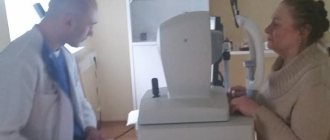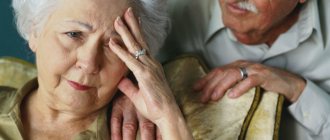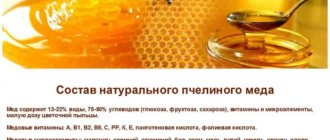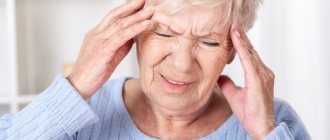Isolated systolic arterial hypertension (ISAH) or hypertension is an increase in upper systolic pressure over 140 mmHg. Art., and the lower one remains within the normal range (90 mm Hg. Art.). If the critical level does not decrease over several months, we can talk about disturbances in the functioning of the heart and the risk of developing vascular complications - myocardial infarction, stroke, hypertensive crisis. Experienced doctors at Elena Malysheva’s clinic will help you avoid the serious consequences of isolated systolic hypertension: treatment will be carried out using new generation antihypertensive drugs.
Causes of hypertension
The main cause of increased upper pressure is vascular atherosclerosis. With age, their elasticity decreases, and atherosclerotic plaques form on the inner surface. This impairs the blood flow of the vascular walls of the arteries due to changes in blood pressure. In addition, a number of factors influence the development of isolated systolic hypertension:
- kidney diseases;
- taking hormonal medications;
- taking non-steroidal anti-inflammatory drugs;
- excessive activity of the thyroid gland, adrenal glands;
- obesity;
- decreased sensitivity of receptors in blood vessels and heart.
Often high systolic pressure is associated with bad habits: smoking, alcohol abuse, consumption of fatty and spicy foods. Pregnant women can also suffer from ISAH, but after childbirth the symptoms of the disease completely disappear without requiring special treatment. ISAH is also more common in older age groups.
O.M. Drapkina First Moscow State University named after I.M. Sechenov Clinic of Propaedeutics of Internal Diseases, Moscow
Isolated systolic arterial hypertension is most often observed in elderly people and is difficult to treat with pharmacotherapy. The article presents a case of successful pharmacotherapy of ISAH using calcium antagonists and olmesartan. Key words: ISAH, elderly people, treatment, olmesartan.
Isolated systolic hypertension as a destiny of elderly hypertensive patients OMDrapkina Internal Medicine Propaedeutic Clinics, IMSechenov FMSMU
Isolated systolic hypertension (ISH) is mostly common in elderly patients and is known to be difficult to treat. The article describes the case of ISH successfully treated with calcium antagonists and olmesartan. Keywords: ISH, elderly patients, treatment, olmesartan.
Information about the author Drapkina Oksana Mikhailovna – Dr. med. sciences, prof. Department of Propaedeutics of Internal Diseases, Faculty of Medicine, First Moscow State Medical University. I.M.Sechenova, head Department of Cardiology, Clinic of Propaedeutics of Internal Diseases, Gastroenterology and Hepatology named after. V.H.Vasilenko, Moscow
Arterial hypertension (AH) is one of the most common cardiovascular diseases (CVDs), which poses a huge threat to the health and life of the population. In the Russian Federation, hypertension is widespread and is observed in 41.1% of women [1, 4]. The frequency of hypertension in the population depends on age and gender. The following pattern is noted: in the age range from 30 to 50–60 years, the prevalence of hypertension is higher among men, after 50–60 years – among women. The problem of arterial hypertension (AH) in elderly women is becoming increasingly relevant, since more than half of women over 60 years of age experience a persistent increase in blood pressure (BP). At the same time, the effectiveness of antihypertensive therapy in women decreases with age (from 20 to 8% after 50 years), while in men it remains almost unchanged (4–7%) throughout life [3]. Elevated normal blood pressure compared to optimal increases the risk of coronary heart disease in women by 4 times, well-corrected arterial hypertension by 8 times, poorly treated arterial hypertension by 19 times [4]. Women are 2 times more likely to die from strokes than men (16 and 8%, respectively) with an equal prevalence of cerebral vascular accidents in both sexes, which is associated with longer life expectancy and higher levels of systolic blood pressure in women [2]. Most often, isolated systolic hypertension (ISAH) is diagnosed in women, i.e. increase in systolic blood pressure to 140 mm Hg. Art. and higher with diastolic blood pressure less than 90 mm Hg. Art. Currently, ISAH is considered as one of the variants of essential (or primary) hypertension, i.e. within the framework of hypertension [5]. The prevalence of ISAH increases with age, exceeding 40% in patients over 60 years of age. Grade 1 ISAH is much more common (compared to grade 2 or 3 ISAH): Grade 1 ISAH, for example, occurs in 1/3 of Americans over 70 years of age. There are primary and secondary ISAH. Secondary ISAH is caused by an increase in cardiac output (for example, with thyrotoxicosis or anemia) or the presence of severe atherosclerosis of the aorta. In the absence of these reasons for an increase in SBP, they speak of the presence of primary ISAH, that is, hypertension. The hemodynamic mechanisms of primary ISAH in elderly people have not been fully established. The vast majority of researchers consider the main mechanism of its formation to be a decrease in the distensibility of the aorta and large arteries, so blood is ejected from the left ventricle into a more rigid and less elastic aorta, which causes an increase in SBP. Distensibility refers to the ability of a vessel to change volume under the influence of changing pressure. A rigid aorta also contributes to the formation of left ventricular myocardial hypertrophy. The decrease in distensibility is closely related to the aging process (loss of elasticity of the fibers of the arterial wall and the deposition of collagen, elastin, glycosaminoglycans and calcium). The importance of highlighting the problem of ISAH is due to the fact that an increase in SBP, including an isolated increase in SBP (with normal diastolic blood pressure), is an important risk factor for the development of cardiovascular complications. Therefore, to regard an increase in SBP as a manifestation of the age norm, as was the case about ten years ago, is a serious mistake that can have the most serious consequences for the patient. It has been established that ISAH increases mortality from cardiovascular pathology by 2–5 times and overall mortality by 51% compared with that in individuals with normal blood pressure. Moreover, in many cases, an increase in systolic blood pressure plays an even greater role in the development of cardiovascular complications: people of all age groups are at risk of developing all cardiovascular complications of hypertension (coronary heart disease, including myocardial infarction, stroke, heart failure, atherosclerosis peripheral arteries) was more strongly correlated with systolic rather than diastolic blood pressure. In Russia, this problem is extremely relevant, since our country, unfortunately, ranks first in the world in mortality from cardiovascular diseases (CVD). It was noted that with an increase in SBP, the relative risk of death from CVD increases more than with an increase in DBP, and at maximum blood pressure values (for systolic - more than 150 mm Hg, for diastolic - more than 98 mm Hg) by 2 times exceeds the risk due to an increase in diastolic blood pressure. In women, the relative risk of developing CVD is 1.3 for isolated diastolic (SBP less than 160 mmHg) hypertension, 3.2 for systolic-diastolic hypertension and 4.1 for ISAH. For men, similar figures are 1.4, 2.3, 2.9 for isolated diastolic, systolic-diastolic and ISAH, respectively. Consequently, the highest risk of developing CVD was recorded in patients with ISAH. In women, hormonal changes in the reproductive system with age cause a number of changes in various organs and systems that predispose to the development of arterial hypertension. Switching off the reproductive function leads to neuroendocrine disorders, which predetermine some features of the course of hypertension in peri- and postmenopause [5, 6]: • the debut of a persistent increase in blood pressure occurs, as a rule, in perimenopause; • there is an increased sensitivity to sodium chloride and a significant increase in total peripheral vascular resistance; • increased vascular reactivity to norepinephrine causes an excessive increase in blood pressure in response to psychoemotional stress, and dysregulation of the release of catecholamines determines high variability of blood pressure during the day; • AH potentiates the clinical picture of menopausal syndrome; • hypertension is often accompanied by menopausal metabolic syndrome; • characteristics of hypertension in postmenopause also include the rapid development of target organ damage and a high incidence of complications. As a woman ages, estrogen deficiency increases. The pathogenesis of hypertension that occurs in perimenopause is based on hypoestrogenism, which leads to the development of menopausal metabolic syndrome [11]. Numerous studies have demonstrated a series of positive effects of estrogen on the cardiovascular system. Their beneficial effect on vasoactive neurohumoral factors has been most proven (reducing the activity of the sympathetic nervous system and the sensitivity of b-adrenergic receptors, stimulating the endothelial production of nitric oxide and prostacyclin, reducing the formation of angiotensin II and the expression of type 1 receptors for it, reducing the level of endothelin-1 and the activity of angiotensin-converting enzyme ). Estrogens also have a positive effect on hemostasis (decrease in platelet aggregation activity, decrease in levels of plasminogen activator inhibitor-1, von Willebrand factor, plasminogen, antithrombin III and fibrinogen). In addition, the effectiveness of their influence on lipid metabolism parameters has been proven - a pronounced antiatherogenic effect (decrease in the levels of atherogenic lipoproteins and increase in antiatherogenic ones); on diuresis (increased natriuresis). Interesting are the results of studies indicating a direct vasodilatory effect of estrogens on arterial vessels, including the coronary arteries. At the same time, there is evidence that the mechanisms of vasodilatory action of estrogens differ depending on the dose: a direct effect through vascular smooth muscle cells is detected when using high doses, and at low doses, vasodilation is mediated primarily due to changes in the activity of endothelial factors - increased oxide formation nitrogen, prostacyclin, decreased synthesis of endothelin-1 and thromboxane B-2. In recent years, data have been accumulated on the positive effect of estrogens on the components of the vascular wall: inhibition of the processes of fibrosis of the vascular wall (decreased synthesis of collagen and elastin in smooth muscle cells), reduction of migration and proliferation of smooth muscle cells and expression of adhesive molecules that promote the attachment of monocytes to endothelial cells, and the level of chemokines involved in the migration of monocytes into the subendothelial layer, reduction of inflammatory factors (C-reactive protein, tumor necrosis factor-a), inhibition of endothelial cell apoptosis. Another important aspect of the action of estrogens is their effect on carbohydrate metabolism - improving tissue sensitivity to insulin and reducing the production of insulin itself. These changes occur in parallel with an improvement in blood lipid parameters and a decrease in homocysteine levels. At the same time, a number of effects have been described for estrogens that are aimed at sodium and fluid retention in the body (an increase in the level of angiotensinogen in the liver with an increase in the formation of angiotensin I and II and induction of aldosterone synthesis) and can lead not only to fluid retention and edema, but and to the appearance of overweight and obesity (primarily of the gynoid type) in women in the premenopausal period. However, under physiological conditions in healthy women during their childbearing years, these effects are counteracted by the antimineralocorticoid activity of progesterone. In addition, the positive effect of estrogens on vascular and metabolic parameters described above, even in the case of obesity, inhibits the development of hypertension, atherosclerosis and carbohydrate metabolism disorders. Taking into account the above, the main pathogenetic mechanism of hypertension in postmenopausal women is the estrogen deficiency that occurs during this period (primarily a decrease in the concentration of 17-B-estradiol) and the associated disappearance of the protective effect of these hormones on the cardiovascular system [7, 8] K The direct consequences of estrogen deficiency, which are of paramount importance for the development of hypertension, include: a decrease in the production of powerful vasodilatory and antiplatelet factors (nitric oxide and prostacyclin), activation of the local (tissue) renin-angiotensin and sympathetic nervous system, sodium chloride retention, the formation of insulin resistance and conditioned her hyperinsulinemia. Hyperinsulinemia contributes to the development of hypertension, causing an increase in sodium reabsorption in the kidneys, intracellular fluid retention, an increase in the concentration of sodium and calcium in the smooth muscle cells of arterioles, their sensitivity to pressor substances, activation of the proliferation of smooth muscle cells of the heart and blood vessels with the formation of their pathological changes or remodeling. Significant factors in the progression of hypertension are: increased platelet aggregation, activation of blood coagulation factors, increased homocysteine levels in the blood under conditions of estrogen deficiency [9]. Disturbances in the hemostatic system that appear in postmenopause significantly increase the risk of thrombosis [10]. Quite often, the metabolic changes described above are associated with impaired purine metabolism and the occurrence of hyperuricemia, which may also be an additional factor in the pathogenesis of hypertension in elderly women. The mechanisms of increased blood pressure in menopausal, including postmenopausal women also involve factors such as impaired socio-psychological adaptation with the development of depression, the emergence or worsening of the smoking habit, and increased alcohol consumption [11, 10].
We present a clinical observation. A 67-year-old patient was admitted to the cardiology department of Clinical Hospital No. 2 of the First Moscow State Medical University named after. I.M. Sechenov with complaints of increased blood pressure to 170 and 80 mm Hg. Art., headache, weakness. From her life history it is known that over the past 10 years she has been experiencing an increase in blood pressure and has been taking calcium channel blockers (CCBs) with a positive effect. However, recently antihypertensive therapy has become ineffective. The patient tried to take angiotensin-converting enzyme inhibitors (ACEIs), to which she noted the appearance of a cough; then angiotensin receptor antagonists - ARA (losartan). However, no clear effect from the therapy was observed. To correct therapy, she was admitted to the clinic. On examination: increased nutrition, pasty legs. Over the lungs, breathing is vesicular; wheezing is not heard. The heart sounds are rhythmic, 1 tone is weakened, the accent of the 2nd tone is over the aorta, systolic murmur in the second intercostal space to the right of the sternum. Blood pressure – 180 and 80 mm Hg. Art., heart rate – 72 beats/min. The liver is at the edge of the costal arch. The kidneys are not palpable. Pasternatsky's symptom is negative on both sides. Data from anamnesis and objective examination indicated that the patient had isolated systolic hypertension, which is a frequent companion of elderly hypertensive patients. According to recommendations for the treatment of ISAH, the drugs of choice are diuretics, CCBs, agents that block the renin-angiotensin system (RAAS) - ACE inhibitors or ARBs. Based on objective examination data and medical history, a diagnosis of arterial hypertension of the 3rd degree, stage II was made. very high risk, atherosclerosis of the coronary and cerebral arteries. The patient belonged to a group of high cardiovascular risk, which required the prescription of combination antihypertensive therapy. For a rational choice, it was necessary to have information about the condition of the kidneys, glycemic profile, lipid profile of the patient, as well as target organ damage. According to the assessment of glomerular filtration rate, the patient had stage 3 chronic kidney disease, the lipid spectrum was characterized by an increase in the level of total cholesterol to 6.5 mmol/l and low-density lipoproteins (LDL) to 4 mmol/l. Considering the above-described clinical profile of the patient, a CCB and an ARA were prescribed as an antihypertensive combination. Since there were indications in the anamnesis that losartan was insufficiently effective, the question arose about choosing another drug from this group. The evidence base for APA is currently extensive. One of the interesting studies, ESPORT, which was carried out in 102 centers in Italy, aimed to evaluate the effectiveness of ramipril and olmesartan in patients aged 65–89 years with ISAH. The duration of the study was 12 weeks. A reduction in blood pressure was achieved in both groups, however, in the olmesartan group, the proportion of patients who responded to treatment was 59% versus 53% in the ramipril group, and the therapeutic effect in the ARA group developed after 2 weeks. Let us recall that our patient had isolated systolic hypertension in old age, which gave us reason to assume the effectiveness of olmesartan in a particular patient. In addition, the presence of microalbuminuria brought to mind the results of the ROADMAP study, which proved that the use of olmesartan delayed the onset of MAU by 23%. Thus, combination therapy was selected: long-acting CCB and olmesartan 20 mg (Cardosal® 20) once a day. In addition, the patient was prescribed statins under the control of ALT, AST, and gamma HT until LDL levels normalized. This clinical observation demonstrates that ISAH remains the province of elderly multimorbid hypertensive patients, requires close attention due to the high likelihood of complications and dictates the need for combined antihypertensive therapy.
Literature 1. Arterial hypertension in postmenopausal women. Round table. Cardiology. 2003; 4:88–95. 2. V.I. Podzolkov, Mozharova L.G., Khomitskaya Yu.V. Arterial hypertension in women with menopausal syndrome. www.cardiosite.ru/https://t-pacient.ru/articles/article.asp?id=4375 3. First Report of experts from the scientific society for the study of Arterial Hypertension, the All-Russian Scientific Society of Cardiologists and the Interdepartmental Council on Cardiovascular Diseases. Prevention, diagnosis and treatment of primary arterial hypertension in the Russian Federation. Clinical pharmacology and therapy. 2000; 9:3:5–30. 4. Nanchahal K., Ashton WD, Wood DA Association between blood pressure, the treatment of hypertension, and cardiovascular risk facts in women. J Hypertens. 2000; 18:833–841. 5. Ostroumova O.D. Isolated systolic arterial hypertension. www.consilium-medicum.com 6. Smetnik V.P. Protective effect of estrogens on the cardiovascular system. Consilium medicum. Extra release. 2002; 3–6. 7. Savelyeva G.M., Breusenko V.G., Kryuchenkova M.E., Gratsiansky N.A., Averkov O.V. Hormone replacement therapy for coronary heart disease. Practical gynecology. 1999; 1:12–20. 8. Samaan SA, Crawford MH Estrogen and cardiovascular function after menopause. JACC 1995; 26 (1465): 1403–10. 9. Kudryashova O.Yu., Zateyshchikov D.A., Sidorenko B.A. Possible role of estrogens in the prevention and treatment of atherosclerosis in women after menopause. Cardiology. 1998; 4:51–58. 10. Britov A.N., Bystrova M.M. Hormone replacement therapy in the prevention of cardiovascular diseases in women with arterial hypertension and coronary heart disease. Consilium medicum. Extra release. 2002; 7–10. 11. Guide to menopause. Ed. V.P. Smetnik, V.I. Kulakova. M: Medical Information Agency. 2001; 685. 12. Prokhorovich E.A., Tkacheva O.N., Adamenko A.N. Features of the clinical course and treatment of arterial hypertension in women. Difficult patient. 2006; 8:13–17.
Types of isolated hypertension
The following types of systolic hypertension are distinguished:
- Primary. In this case, the disease develops in the presence of two or more risk factors.
- Secondary. It is usually a complication of various diseases, hereditary and congenital pathologies.
There is a so-called false form of ISAH, when the upper pressure increases briefly in patients with a head injury or with a fear of people in “white coats”.
Treatment of isolated systolic hypertension
The classic treatment regimen for systolic hypertension is developed taking into account the severity of the identified disease, age and individual characteristics of the patient. In the first stages, a minimum dosage of the drug is prescribed, which allows you to gradually reduce the level of upper blood pressure. In addition to therapy, the doctor can give recommendations on adjusting your diet, daily routine and rest. Practice shows that the introduction of moderate physical activity, giving up bad habits, limiting the consumption of salt, spicy and fatty foods can normalize the patient’s condition, improve the quality and extend his life.
Symptoms
The symptoms and course of ISAH are often accompanied by manifestations of cerebral, coronary and renal disorders. High blood pressure contributes to the development of complications from the heart, blood vessels and mortality. Pulse pressure is an indicator of the biological age of the arteries.
Older people usually have a long history of illness. But at the same time, often with hypertension, obvious symptoms of the disease are not very pronounced or even completely absent. Patients do not complain at all about anything, but at the same time, dysfunction of the heart, kidneys and brain is diagnosed.
Many cardiovascular (heart failure, stroke, heart attack) and metabolic (gout) complications occur. There may be an increase in total peripheral blood flow resistance.
There are false forms of the disease due to increased vascular stiffness, white coat hypertension (fear of doctors) or orthostatic (after head injury).
Patients need 24-hour blood pressure monitoring and corrective therapy to reduce the likelihood of developing CVD
More than half of elderly patients experience a nocturnal increase in blood pressure or, conversely, an excessive decrease during sleep. There is also often a pronounced and rapid rise in blood pressure in the morning. The described signs of imbalance in the circadian rhythm of blood pressure are harbingers of severe disorders and confirm the danger of target organ damage.
Detailed consideration of individual groups of drugs
Diuretics
This group of drugs for hypertension is prescribed to almost all patients. Diuretics reduce the stroke volume of the heart, the volume of circulating plasma and improve the distensibility of the arteries. In combination with beta-blockers, they prevent coronary artery disease, cerebrovascular disorders and overall mortality.
Diuretics are the first choice in the treatment of hypertension
b-blockers
The drugs in this group alone only protect against cerebrovascular complications. Since they affect the conduction system of the heart, when using beta-blockers it is necessary to monitor heart rate and ECG.
Calcium antagonists
They help increase the elasticity of the arteries and thereby reduce systolic pressure. The antihypertensive effect either increases with age or does not change.
Studies show that treatment of ISH with calcium antagonists prevents the development of many complications, improves the prognosis and quality of life of the patient. But there is an opinion that this group of drugs increases the risk of developing malignant tumors.
Features of treatment
Scientists have found that by treating hypertension with antihypertensive therapy, the risk of complications and mortality can be reduced.
At the beginning of treatment, doctors usually prescribe: sartans, calcium antagonists, beta blockers and ACE inhibitors, taking into account general recommendations. With the right therapy, the blood pressure level should reach 140/90 mm Hg. and below. The effectiveness of complex treatment has been proven.
Studies have shown that treatment of people with ISAH with the above drugs has a positive effect regardless of age, with a decrease in the incidence of coronary artery disease and other cardiovascular complications.
Treatment of hypertension should first of all begin with non-drug methods of therapy, this is the fight against excess weight, muscle relaxation, limiting salt intake, dosed physical activity, autogenic training, electrosleep, giving up alcohol and cigarettes, exposure to music.
When choosing drugs, the doctor must take into account 2 main factors - hemodynamic mechanisms and the patient’s age. This is especially important for older patients, since various variations of hypertension are much more common in them.
Vasoactive agents effectively reduce arterial tone and increase their distensibility. The pressure decreases as the ejection of blood from the left ventricle decreases. When used regularly, diuretics reduce plasma volume and stroke volume of the heart.
To prevent complications and treat ISAH, it is better to take first-line antihypertensive drugs. Even with long-term use, they do not accumulate fluid, do not disrupt carbohydrate and lipid metabolism, do not provoke an orthostatic reaction and do not suppress the activity of the central nervous system.
These medications include ACE inhibitors (ramipril, enapril, captopril, cilazapril), beta-blockers (bisoprol, atenolol, metoprolol, pindolol), thiazide diuretics (hypothiazide) and calcium antagonists (amlodipine, isradipine, nifedipine, verapamil).
Elderly patients should carefully select the dose with constant monitoring of blood pressure. In this case, the measurement is performed while standing and not on an empty stomach. At the beginning of treatment, blood pressure should be reduced gradually, by about 30% of the first values, so as not to cause renal or brain failure. Constantly monitor kidney function, carbohydrate and electrolyte metabolism.
European doctors often prescribe a combination of an ACE inhibitor and hydrochlorothiazide because they multiply the joint effect and stimulate natural compensatory feedback processes. In almost any case, drugs from two different groups are prescribed. Thus, the risk of side effects is reduced.
When is the diagnosis made?
A doctor can diagnose ISAH if, at the last three visits, the average systolic blood pressure level is > 140 mm Hg, and the average diastolic blood pressure level is
When measuring blood pressure in older people, inflate to 250 mm Hg. and slowly release it. The patient must stand or sit. To detect hypertension, blood pressure should be checked in both arms.
If the diagnosis of hypertension is made after 60 years or practically cannot be corrected, then it is necessary to exclude secondary hypertension caused by atherosclerosis of the renal arteries.
How to reduce systolic blood pressure
The goal of treating isolated systolic hypertension is to stop the pathology and reduce the risk of complications. To do this, the patient is prescribed a number of medications, selected by the doctor on an individual basis. Blood pressure begins to decrease when taking ACE inhibitors, beta-blockers (calcium channel blockers), diuretics, beta blockers, angiotensin receptor blockers, calcium antagonists. In the initial stages of the disease, non-drug treatment is tried.
- Anticoagulants - what they are and a list of drugs. The use of direct and indirect anticoagulants
- Kefir muffins - step-by-step recipes with photos
- Haircut with hot scissors: pros, cons, before and after photos of hair
Non-drug treatment
A mandatory measure to eliminate ISH is a diet that involves reducing the consumption of fatty, salty foods. In addition, you must stop drinking coffee, alcohol, strong tea, and stop smoking. To normalize blood pressure, it is important to fight excess weight. The doctor may prescribe:
- Balanced nutrition menu. The basis of the diet is low-fat fermented milk products, fruits, vegetable oils, bran, sea fish, and poultry. At the same time, animal fats, sweets, and pickles are reduced to a minimum. Salt consumption is reduced to 2.4 g per day, and its content in the food consumed must be taken into account.
- Regular walks, exercise therapy, sports. Suitable for swimming, tennis, cycling, etc.
- Methods for increasing stress resistance. You may need help from a psychotherapist.
- Traditional medicine. They use herbal decoctions, mixtures of fresh fruit and vegetable juices, and beekeeping products.
Drugs to lower systolic blood pressure
Medicines to lower blood pressure in ISH should reduce only the upper level, leaving the lower one unchanged. In people with diabetes, it is necessary to achieve the upper figure of the tonometer to 120 mmHg. Art., for the rest the tonometer scale should show 140 mm Hg. Art. or lower. The change in pressure should occur gradually so as not to provoke an ischemic stroke, loss of consciousness, etc. The following medications are used to treat isolated systolic hypertension:
- Triampur. Belongs to a group of drugs called “diuretics”, contains triamterene and hydrochlorothiazide. Diuretics reduce the reabsorption of sodium ions in the distal tubules. In addition, the medicine removes calcium, chlorine, sodium and water ions from the body, while slowing down the process of excretion of calcium ions. For the treatment of isolated systolic hypertension, a daily dosage of 2 to 4 tablets is prescribed.
- Betalok. A drug from the group of B-adrenergic blockers, which, when entering the body, begin to block specific beta receptors, preventing cardiac complications. As a rule, they are prescribed together with other drugs, however, in the initial stage of isolated systolic hypertension, they can independently bring the pressure back to normal. The dosage is agreed with the attending physician.
- Nifedipine. The drug belongs to the category of calcium antagonists. The action of the drug is based on blocking calcium channels in cells, as well as on disrupting the contraction of fibers of the vascular walls. As a result, the blood vessels relax, which are less responsive to nerve signals and stop spasms. The functioning of the circulatory system returns to normal after taking the pills. At the beginning of treatment, 1 tablet is prescribed 2-3 times a day; if necessary, the dosage is increased to 2 tablets 1-2 times a day.
- Enalapril. As a rule, drugs of this type (ACE inhibitors) are prescribed to patients with diabetes mellitus and people with left ventricular systolic dysfunction. The drug is able to control the action of the enzyme that causes vasospasm and the development of arterial hypertension. For isolated systolic hypertension, the usual dose of the drug is 2.5-5 mg, but can reach 20 mg as prescribed by a doctor.
Diagnostics
Arterial hypertension is confirmed by a doctor if, during three patient visits at intervals of a couple of weeks or during independent blood pressure measurements, its level is more than 140/90 mmHg. Art. If there are characteristic symptoms of hypertension, it may not be possible to record an accurate pressure reading, then you need to carry out daily monitoring, paying close attention to the night and morning blood pressure levels. To determine the causes of the disease, confirm or refute secondary isolated systolic hypertension, the following are prescribed:
- study of renal fractions;
- biochemistry, general blood test;
- ECG, ultrasound of coronary arteries, heart;
- lipid profile;
- Ultrasound of the adrenal glands, kidneys;
- analysis of thyroid hormones, etc.











